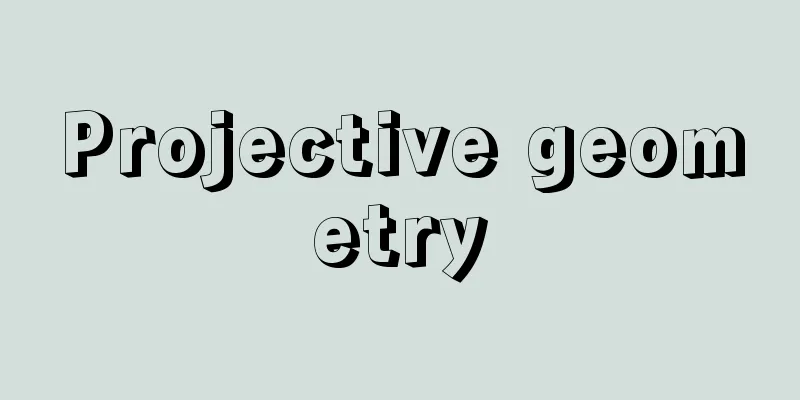Projective geometry

|
Geometry studies the properties of figures that are invariant through projective correspondence (projective transformation). For example, "several points are on the same line (or plane)" is a projectively invariant property. On the other hand, as shown in , if two intersecting lines g 1 and g 2 are projected from point O and cut by plane π, two parallel lines h 1 and h 2 are obtained, so "parallel" is not an invariant property. The length and angle of line segments are also not invariant, so they have no meaning in projective geometry. The simplest projective invariant is the anharmonic ratio of four points and four lines, which plays a fundamental role in projective geometry. Figures that can be transferred to each other through projective correspondence are called projective congruence, and this concept of congruence corresponds to ordinary congruence in Euclidean geometry. Affine geometry is constructed by affine correspondence, which is a specialization of projective correspondence. Euclidean geometry can be seen as a more specialized form of affine correspondence, that is, the study of the properties of shapes that are invariant under Euclidean congruent transformations. Non-Euclidean geometries are constructed similarly, so projective geometry is a more general form that encompasses all of these. Projective geometry is also one of the most axiomatically clear and beautiful forms of mathematics. It starts from fewer and simpler axioms than Euclidean geometry, and can develop geometry through rigorous proof. In particular, a notable feature of projective geometry is that it has complete duality, as described below. Let us now consider the proposition "There is exactly one line that passes through two points." In this proposition, if we replace "point" ↔ "line" and "pass through" ↔ "on," we get "There is exactly one point that is on two lines." Creating a new proposition from one proposition through such replacement is called duality. The axiom system of projective geometry also contains the dual of each axiom. Therefore, if one proposition is true, its dual proposition is necessarily true without the need for additional proof. The axiom system of Euclidean geometry is not like this. Projective geometry is said to have originated from the perspective drawing method of the Renaissance, but it was the French architect Desargues who paved the way for modern-day projective geometry. Inspired by the work of Desargues, Pascal discovered many projective geometric properties related to conic curves, including the theorem known today as Pascal's theorem. Later, French engineer Poncelet participated in Napoleon's Russian campaign and was captured, but discovered the principle of duality based on his research while in prison. [Tachibana Shunichi] ©Shogakukan "> Projective Geometry (Diagram) Source: Shogakukan Encyclopedia Nipponica About Encyclopedia Nipponica Information | Legend |
|
射影対応(射影変換)によって不変な図形の性質を研究する幾何学である。たとえば、「いくつかの点が同一直線(または平面)上にある」は射影的に不変な性質である。一方、のように、交わる2直線g1、g2を点Oから射影し平面πで切断すれば、平行2直線h1、h2が得られるので、「平行」は不変な性質ではない。線分の長さ、角も不変ではないから射影幾何学では意味をもたない。もっとも簡単な射影的不変量は4点および4直線の非調和比で、これらは射影幾何学で基本的役割を果たすものである。射影対応で互いに移りうる図形を射影的合同といい、この合同概念はユークリッド幾何学での普通の合同に対応する役目をする。射影対応を特殊化したアフィン対応によってアフィン幾何学が構成される。ユークリッド幾何学は、アフィン対応をさらに特殊化した対応、すなわち、ユークリッド的合同変換で不変な図形の性質を研究する幾何学とみることができる。非ユークリッド幾何学も同様に構成されるので、射影幾何学はこれらすべてを包含する、より一般的な幾何学である。 射影幾何学はまた公理論的にもっともすっきりした美しい数学の一つで、ユークリッド幾何学に比べてはるかに少なく簡明な公理から出発し、厳密な論証によって幾何学を展開することができる。とくに射影幾何学では次に述べるように完全な双対(そうつい)性が成り立つことが著しい特徴である。いま、「2点を通る直線はちょうど一つ存在する」という命題を考えてみよう。この命題において、「点」↔「直線」、「を通る」↔「の上にある」の置き換えをしてみれば、「2直線の上にある点はちょうど一つ存在する」となる。このような置き換えによって、一つの命題から新しい命題をつくることを双対とよぶ。射影幾何学の公理系はそのどの公理の双対もまたこの公理系のなかに存在している。したがって、一つの命題が真ならばその双対命題は改めて証明しなくても必然的に真となる。ユークリッド幾何学の公理系はこのようにはなっていない。射影幾何学のおこりはルネサンス期の遠近画法であるといわれるが、今日の射影幾何学の端緒を開いたのはフランスの建築技術者デザルグである。パスカルはデザルグの仕事に刺激されて、今日パスカルの定理とよばれる定理をはじめとして円錐(えんすい)曲線に関する多くの射影幾何学的性質を発見した。その後、フランスの工兵士官ポンスレはナポレオンのロシア遠征に参加して捕虜となったが、獄中での研究をもとに双対の原理をみいだした。 [立花俊一] ©Shogakukan"> 射影幾何学〔図〕 出典 小学館 日本大百科全書(ニッポニカ)日本大百科全書(ニッポニカ)について 情報 | 凡例 |
Recommend
FAB - Fab
A factory that manufactures chips. It is an abbrev...
Iami
...The prototype is considered to be the represen...
Kakudo - Kakudo
[1] 〘 noun 〙① A corridor elevated above ground. [S...
Corvidae
...Also closely related to the crow genus are the...
Compression ratio -
When pressure is applied uniformly from all sides...
Sula abotti (English spelling)
…[Hiroshi Hasegawa]. … *Some of the terminology e...
feeble magnetism
…Although it does not show the remarkable effect ...
Jaki - evil spirit
〘Noun〙 A god who curses . Also, a demon . A vengef...
Trichomonas tenax
…[Kawaguchi Hiroaki]. … *Some of the terminology ...
Adjuvants
A substance that enhances antibody production whe...
Yield - Rimawari (English spelling) Yield
The ratio of dividends, interest, etc. resulting ...
Directrix - junsen (English spelling)
In a conic section, a sphere can be created that i...
hypopus
…Acarid mites generally consist of five stages: e...
Jardini
… The finest surviving examples of this Italian s...
Root hair - Konmou
These hairs are found near the tip of the root an...









